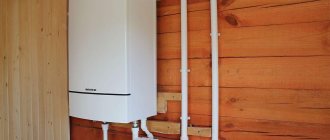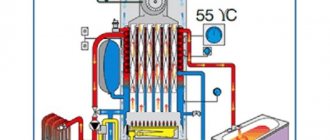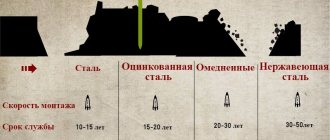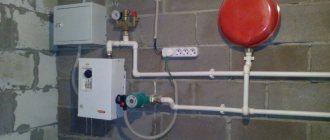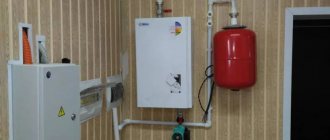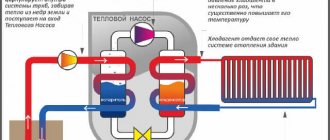The idea of heating a house with electricity looks attractive, because it is the most comfortable type of heating. But the cost of energy is cause for concern. Therefore, the homeowner wants to assess in advance what costs the electric boiler will incur - whether it is profitable or not to use this device, and what difficulties there may be.
Features of heating a house with electricity
If you do not take into account operating costs, the choice in favor of such a heating system can only be characterized positively:
- No chimney required.
- There is no risk of fire (provided the connection rules are followed), explosion and gas poisoning.
- No design or permission from government agencies is needed.
- Full automation. Unlike the gas analogue, it is safe to start the device in the absence of occupants for a long time.
- The heating output is regulated within a wide range without reducing efficiency.
- The boiler is inexpensive.
But there are also negative points:
- High electricity costs.
- Low reliability. The overhead power grid is the most vulnerable part of the infrastructure.
After storms and hurricanes, populated areas are the first to remain without electricity. Therefore, it is risky to make do with an electric boiler alone; it is recommended to additionally connect at least a low-power solid fuel device to the heating system as a backup. The list of units is on the website.
Alternatives to electric boilers
In addition to electric boilers, there are other devices that can be used to heat your home. Let's look at the most popular ones.
Electric convectors
These are heaters that work on the principle of convection - air masses circulate through the convector and heat up. Well suited for heating private houses. Among the advantages over electric boilers: easier installation - floor models just need to be installed, wall-mounted ones mounted on the wall, installation of pipes and other elements of the heating system is not required, which greatly simplifies and reduces the cost of organizing heating. There are electric convectors with remote control and electronic thermostats, thanks to which significant energy savings can be achieved. These devices are fireproof, easy to operate, and efficient—the room warms up evenly and quickly.
Electric infrared heaters
These are heaters that operate on the principle of infrared radiation. We do not recommend them for heating private houses: infrared heaters are designed for rooms with high ceilings, and in an ordinary house with a ceiling of 2.5, you will not get savings from an infrared heater, but inconvenience. The heater cannot cover the entire room with radiation, either when placed on the wall or when placed on the ceiling. And it heats only those objects that are in the radiation zone. As a result, where the radiation falls a person will be very hot, and in the rest of the house it will be cold.
What you need to know before installing heating
The power of the line supplied from the power transmission line is limited. According to Decree No. 334 of the Government of the Russian Federation, which came into force in April 2009, energy networks are required to allocate 15 kW per household. At first glance, this is a lot: on average, an electric boiler of this power can heat a house with an area of up to 150 square meters. m.
But there are other energy-intensive receivers in the home and on the property: a boiler, washing machine and dishwasher, oven, microwave, equipment in the workshop, etc. It is necessary to assess the level of consumption and calculate how much is left for heating.
If you apply to Rostekhnadzor, the limit may be raised. But in some regions the state of the networks does not allow this. There is a solution, but it can be expensive: sometimes a homeowner has to pay to replace a transformer at a substation in order to connect a powerful heater.
Example of electricity consumption
For clarity, you can consider the organization of heating in a house with an area of 90 square meters. m, located in the Moscow region. There are electrical appliances with the following power consumption:
- water heater and washing machine: 1.5 kW each;
- 2 socket groups with 10 A circuit breakers, i.e. designed for a power of 220 × 10 = 2.2 kW each;
- internal and external lighting, supply and exhaust ventilation system with recuperator: total 1 kW.
The kitchen stove runs on bottled gas.
The total power consumption is 8.4 kW. 15 – 8.4 = 6.6 kW remains for heating.
The required rated power of the boiler corresponds to heat loss in the coldest week of the year + a reserve of 20%. To calculate them, a complex calculation is required, but a less accurate simplified version can be applied to a standard house: Q = S × K, where
Q – heat loss in the coldest week, W;
S – heated area, sq. m;
K – specific heat loss, W/sq. m.
Depending on the region, K is taken equal to a fixed value:
- southern regions: 60-80;
- central part of the country: 90-110;
- northern districts: 120-200.
According to the condition, the house is located in the Moscow region, we can assume that K = 100 W/sq. m.
Taking into account a reserve of 20%, the power of the heat generator in the coldest week will be:
W = 90 × 100 × 1.2 = 10,800 W = 10.8 kW.
Conclusion: to help the 6.6 kW electric boiler, it is necessary to install a solid fuel boiler - 4.2 kW. Or one combined one, running on wood and coal, but with heating elements in the heat exchanger.
What determines the actual power consumption?
The most significant power consumption of an electric heating boiler depends on:
- Operating conditions . Namely, on the desired temperature regime (a decrease in temperature by 1°C implies up to 5% savings), constancy of residence in the house and regulation of indicators during sleep or absence of the owners of the house.
- Technical condition of the boiler . Namely, its heating elements (tubular electric heaters). When using hard, untreated and constantly replaced water as a coolant, scale forms on heating elements, which reduces efficiency from 99% to 90.80 and even 70%. To heat the coolant to the previous temperature through a layer of scale, the electric boiler requires more energy and time.
- Equipment . The circulation pump and advanced automation consume from 60 to 150 W. However, these are not so significant values against the background of already expensive operating costs.
- Automation functionality . Advanced modern automation has several operating modes, more competently controls the switching on and off of heating elements, the operation of the circulation pump, smoothly regulates the temperature, and allows you to set hysteresis values. Electric boilers in the middle and higher price categories are often equipped with the ability to program the operating mode, which significantly affects consumption.
Which electric boilers are most often used to heat a private home?
There are 4 varieties:
- heating elements;
- electrode;
- induction;
- heat pumps.
The first ones are the most common. Their advantages:
- affordable price;
- low requirements for the coolant: it only needs to be desalted once before the first use;
- simple and inexpensive repairs;
- soft start (prevents power surges in the network).
Electrode boilers are cheaper than heating elements and are simpler in design. But the user has to prepare the coolant according to the recipe. At the same time, its chemical composition is constantly changing, so every 1.5 months it is necessary to pour new liquid into the circuit. This makes operation difficult.
Induction boilers, on the contrary, are able to work with any coolant, but their price is 4 times higher than that of heating elements.
Both of the latter types have a common drawback: their design does not provide for a soft start, so when switched on, voltage surges occur in the network.
If funds allow, it is advisable to purchase a boiler that operates on the principle of a heat pump. It is beneficial to use it. For every kilowatt of electricity consumed, the device produces up to 5 kW of heat. But the system will require a lot of money: in addition to purchasing an expensive device, you will have to pay for the construction of an extensive external heat exchanger (a long circuit of pipes in the ground).
Electricity costs for heating a house
The boiler reaches its rated power mode only during the coldest five-day period of the year. The rest of the time it operates with reduced heating output. On average it is:
- in the winter months (December, January and February): 50% of nominal;
- in November and March: 30%;
- in October and April: 15%.
For example, a 10 kW electric boiler will consume:
- During the winter months: 10 × 0.5 × 24 hours × 90 days = 10,800 kWh.
- For November and March: 10 × 0.3 × 24 × 61 = 4,392 kWh.
- For October and April: 10 × 0.15 × 24 × 61 = 2,196 kWh.
Total: 10,800 + 4,392 + 2,196 = 17,388 kWh.
In 2022, in the Moscow region, the tariff for houses with electric stoves and heating corresponds to 3.89 rubles/kWh. This means that the costs for the season will be 17,388 × 3.89 = 67,639.32 rubles.
Accordingly, if we talk about an electric boiler for heating a house of 200 square meters, the amounts will be much higher.
Calculation of average annual heat loss
Using the same principle, we calculate the average annual heat losses, where instead of T av = - 30 degrees, we substitute the average annual T avg. = +4.4 degrees taken from SNIP 01/23/99.
- Q windows = 3.6 x (20+4.4)/0.4 = 219 W
- Q walls = 104.4 x (20+4.4)/5.17 = 492.7 W
- Q roof = 100 x (20+4.4)/5.17=472 W
- Floor Q = 80 x (20+4.4)/4.95)+48 x (20+4.4)/7.15)+ 4 x (20+4.4)/11.45)=565 W
- Q total = 219+492.7+472+565=1748 W
So, we got the average annual consumption per hour at home - 1.7 kW; The average annual consumption per year will accordingly be 14,892 kW
This is exactly how much heat loss we will need to compensate when heating the house, regardless of the equipment chosen!
What affects electricity consumption
All boilers convert the energy used into heat in a 1:1 ratio. With 100% efficiency, negligible losses in wires and connections are neglected. The exception is heat pumps, but they are still rarely used.
Thus, there are only 2 ways to reduce electricity consumption:
- Reduce heat loss. To do this, the home is covered with mineral wool or polystyrene foam, and the cracks are sealed.
- Optimize the operation of the boiler in order to eliminate excessive consumption of energy resources.
The second problem is also solved in 2 ways:
- Using weather-sensitive automation. Such a system promptly warns the boiler about the onset of warming, and it manages to reduce power without overheating the room.
- Programming. A model with this function, according to user settings, reduces heating output when residents are at work or sleeping. The rest of the time the device returns to normal mode.
For inexpensive heaters, the first option is not suitable. They do not have the function of connecting weather-compensated automation. Then it is recommended to install at least a remote thermostat: it maintains the room temperature at a given level.
It is possible, without reducing consumption, to reduce financial costs. They are switching to differentiated metering of electricity consumption with a big discount at night (RUB 1.68 instead of RUB 3.89). The heating system is equipped with a heat accumulator - a large capacity in which the boiler raises the temperature of the working environment to +98˚C within a grace period. During the day, boiling water is gradually supplied from it through the mixing unit into the circuit as needed; the heater does not work at this time.
In this case, you will have to pay 17,388 × 1.68 = 29,212 rubles for the season. But there is a nuance: the rated power of the boiler should be twice the design power, because at night it works both for heating and for “charging” the heat accumulator. For the example given, a 20 kW unit will be required.
Consumption calculation
What kind of electricity consumption an electric boiler has can be found out if you take into account the generally accepted rules:
- Firstly, to heat one cubic meter with a heat generator, you need (let’s take the average value) 4-8 Wh of electrical energy consumption. The exact figure depends on the results of calculating the heat losses of the entire building and the specific value during heating. Calculations are made using an indicator that takes into account additional heat loss through parts of the walls of the building, through pipelines running in rooms without heating.
- Secondly, when calculating how much electricity an electric boiler consumes, they use the duration of seasonal heating (seven calendar months).
- Thirdly, if you want to find out the average power indicator, use the following provision. To provide heat to an area of 10 m² with structures with excellent insulation, up to three meters in height, 1 kW is enough. It turns out, for example, to heat an area of 180 m², the power of an 18 kW unit will be sufficient. Be aware that if a boiler is selected with insufficient power characteristics, then a favorable microclimate will not be achieved. If the boiler power is too much for a given room, then excess energy consumption will occur.
- In order to find out how much electricity an electric boiler consumes per month, serving an average building, you will need to multiply the power of the unit by the number of hours of its operation per day (continuous operation).
- The data obtained is divided by two. It is worth remembering that a constant maximum load for all seven months is not typical for the boiler (i.e., thaw periods, a decrease in heating temperature at night, etc. are excluded). Thus, we get a result showing how much an electric heating boiler consumes per month. This is an average indicator of the amount of energy.
- If we multiply this figure by the seasonal heating time, i.e. seven months, then you get the total electricity consumption for a year of heating.
Taking into account the price per unit of power, the total needs for heating the house are calculated.
Formula for thermal engineering calculation of power W = S x W beats /10 W beats /10 - specific power per 10 m²; S is the area of the heating space, m².
Other heat sources
To estimate how much an electric heating boiler consumes per month, you need to compare it with other energy sources. It should be taken into account that the efficiency of fuel boilers does not reach a hundred: for gas boilers it is about 93%, for wood and coal boilers it is about 85%.
Below is the cost per 1 kWh for different types of fuel:
- Natural gas: 0.68 rubles, taking into account efficiency – 0.75 rubles.
- Oak firewood: 1.09 and 1.36 rubles, respectively.
- Coal: 1.33 and 1.57 rubles.
- Wood pellets: 1.51 and 1.78 rubles.
- Liquefied gas: 1.99 and 2.13 rubles.
- Diesel fuel: 3.51 and 3.90 rubles.
In each case, heating costs for the season will be (for 17,388 kWh):
- natural gas: RUB 13,041;
- oak firewood: RUB 23,648;
- coal: RUB 27,300;
- wood pellets: RUB 30,950;
- liquefied gas: RUB 37,036;
- diesel fuel: RUB 67,813.
The average price level is given.
In cases where it is not possible to use a solid fuel or gas unit, installing an electric boiler for heating a private home is a good option.
Why is all this needed?
The problem should be considered from two points of view - from the point of view of apartment buildings and private ones. Let's start with the first ones.
Apartment buildings
There is nothing complicated here: gigacalories are used in thermal calculations. And if you know how much thermal energy remains in the house, then you can present the consumer with a specific bill. Let's give a small comparison: if centralized heating operates in the absence of a meter, then you have to pay according to the area of the heated room. If there is a heat meter, this in itself implies a horizontal wiring type (either collector or serial): two risers are brought into the apartment (for “return” and supply), and the intra-apartment system (more precisely, its configuration) is determined by the residents. This kind of scheme is used in new buildings, thanks to which people regulate the consumption of thermal energy, making a choice between savings and comfort.
Let's find out how this adjustment is carried out.
1. Installation of a general thermostat on the return line. In this case, the flow rate of the working fluid is determined by the temperature inside the apartment: if it decreases, the flow rate will accordingly increase, and if it increases, it will decrease.
2. Throttling of heating radiators. Thanks to the throttle, the passage of the heating device is limited, the temperature decreases, and therefore the consumption of thermal energy is reduced.
Private houses
We continue to talk about calculating Gcal for heating. Owners of country houses are interested, first of all, in the cost of a gigacalorie of thermal energy obtained from one or another type of fuel. The table below may help with this.
Table. Comparison of cost of 1 Gcal (including transport costs)
* - prices are approximate, since tariffs may differ depending on the region, moreover, they are constantly growing.
Conclusion
Heating with electricity is unprofitable - only diesel fuel is more expensive. But if it is possible to implement a scheme with a heat accumulator, the energy resource's costs will reach the level of coal and will be comparable to natural gas (the difference will be 25%). This makes sense, especially when you consider the many benefits of electric heating. In any case, each user decides for himself whether to install an electric boiler or convectors as an alternative.
Prices: summary table
| Model | Type | Cost, rub. |
| EVAN EPO-24 | heating elementnew | 16 000-23 000 |
| REKO 24P | heating elementnew | 26 000-29 800 |
| Kospel EKCO.R2-24 | heating elementnew | 39 000-48 000 |
| Bosch Tronic Heat 3500 24 RU | heating elementnew | 63 200-70 000 |
| Galan Vulcan 25 | electrode | 8 400-9 500 |
| Beryl-25 Ion | electrode | 9 600-15 000 |
| Alternative energy VIN-20 | induction | 55 000-64 000 |
